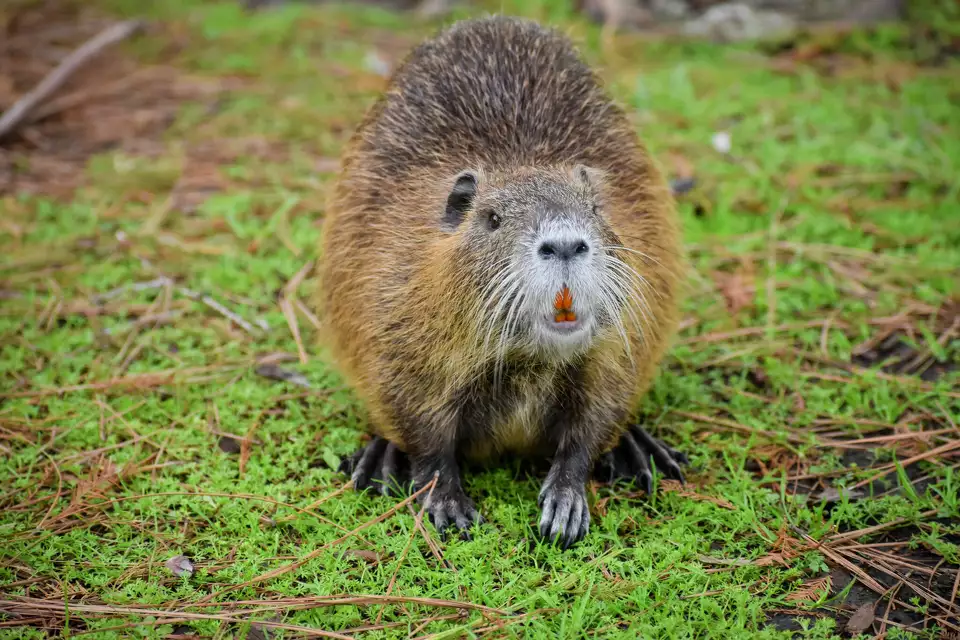Invasive rodents from South America spread further in Houston communities
Nutria appear to be coexisting with another invasive species in the area.
By Ariana Garcia,Assistant News EditorDec 11, 2024
Nutria have visible large front teeth that are orange to yellow in color used for gnawing.
The Pearland area is no stranger to invasive animals, from muscovy ducks to black leatherleaf slugs, the place is seemingly crawling with them. But during a weekend drive near the Southbelt Hike & Bike Trail, I encountered a non-native creature I hadn't spotted in the area before. It looked like a cross between a beaver and a capybara, with soft-looking, dark-colored fur; webbed feet; and a long, sparsely-haired tail. A "capybeaver," my sister lovingly called it after I later told her about the encounter. "Cute," I thought, that is, until it flashed its large, hideously orange buck teeth at me. Then it dawned on me that I'd previously heard the name of this mysterious animal with menacing-looking incisors, and there was no longer anything cute about it: Nutria.
Nutria, which resemble beavers, are about 2 feet long and can weigh up to 20 pounds.
I followed the rodent until it made a dash for the water and quickly swam below the culvert to the connected pond on the other side of the road. There, I found it feasting on a pile of lettuce and limes, likely left on the sidewalk for the resident muscovy ducks, which didn't look too pleased to be sharing their meal. When I approached to grab a photo, a rustling of leaves caught my attention. I turned around and found six more nutria of varying sizes hiding in a bush. Not only was this the first time I'd seen the huge rodents in the area after living nearby for almost a decade, but the creatures appeared totally settled in. "The beavers are so cute," a pair of teenagers walking past told me.
Nutria appear to be coexisting with muscovy ducks, another invasive species near Pearland.
Ariana Garcia
Hailing from South America where they are known as coypu, the semi-aquatic rodents—which measure up to 2 feet and can weigh up to 20 pounds—are far from home. Nutria were brought to the U.S. in the late 1800s for the fur trade and have since dispersed across much of the southern and eastern parts of the country. They've been found in a least 20 states, most recently in California. The beaver imposters were first detected in Texas in the early 1940s, their spread later aided by a hurricane. Experts say the populations of the swamp rats are increasing, and are especially common in the eastern and southern parts of the state. What's more, they can multiply at astonishing speeds, producing multiple litters per year.
Nutria, which are excellent swimmers, can be highly destructive to native plants and vegetation.Ariana Garcia
In the Houston area, nutria have most recently been sighted in places like Memorial Park and Woodland Park, according to iNaturalist. Last year, the giant river rats wreaked havoc in neighborhood communities in Katy. Along the Gulf Coast, nutria sightings have also frequently been reported in Quintana, Galveston, and Jamaica Beach. While "cute" to some, their increased presence in the region is alarming.

With the ability to consume up to 25 percent of their body weight each day, nutria are wildly damaging. The fast-breeding rodent species destroy marshes and other wetlands by devouring native plants that hold wetland soil together. Sometimes, the damage is so severe that it can cause these areas to become open water, according to the U.S. Department of Agriculture. Their shallow burrows, which can extend up to 150 feet, destroy the banks of ditches, lakes, and other water bodies. The long-term damage nutria cause to marsh vegetation subsequently affects the plant and animal species that also inhabit those areas. They can also cause extensive damage to structural foundations such as dikes and roads. Nationwide, nutria destroy more than $1 million in crops annually, according to the Texas Invasive Species Institute.

Despite their healthy-sounding names, nutria are also known to carry diseases that can be transmitted to humans, pets and livestock. The invasive rats can also contain parasites that can contaminate drinking water supplies and swimming areas.
Texas wildlife officials have warned to avoid feeding ducks as it can attract nutria, which tends to be communal feeders often dining with company. The state lists nutria as nuisance fur-bearing animals, meaning Texans can shoot or trap them on their land without a hunting or trapping license. Landowners who want to trap and relocate nutria should notify the Texas Parks and Wildlife Department (TPWD). If you spot the pests, it's probably best to report them to Texas Invasives, TPWD, or a local animal control office. |






